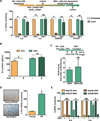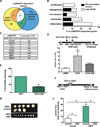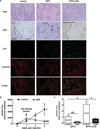p38MAPK plays a crucial role in stromal-mediated tumorigenesis
- PMID: 24670723
- PMCID: PMC4049323
- DOI: 10.1158/2159-8290.CD-13-0743
p38MAPK plays a crucial role in stromal-mediated tumorigenesis
Abstract
Neoplastic cells rely on the tumor microenvironment (TME) for survival and progression factors. Indeed, senescent and cancer-associated fibroblasts (CAF) express factors that promote tumorigenesis that are collectively referred to as the senescence-associated secretory phenotype (SASP). Despite their importance in tumorigenesis, the mechanisms that control TME-derived factor expression remain poorly understood. Here, we address a key unanswered question: how the SASP is sustained in senescent fibroblasts and CAFs. We find that the mitogen-activated protein kinase p38 (p38MAPK) controls AUF1 occupancy on SASP mRNAs and thus controls their stability. The importance of this regulatory mechanism is underscored by our findings that stromal-specific p38MAPK inhibition abrogates the tumor-promoting activities of CAFs and senescent fibroblasts. Our data suggest that targeting SASP mRNA stability through inhibition of p38MAPK will significantly aid the development of clinical strategies to target the TME.
Significance: The TME plays a key role in tumorigenesis. We demonstrate that p38MAPK governs a posttranscriptional mechanism that sustains the protumorigenic SASP. Inhibition of p38MAPK abrogates the tumor-promoting activities of CAFs and senescent fibroblasts. Thus, p38MAPK is a TME-specific Achilles' heel that may be exploited as a new therapeutic target.
©2014 American Association for Cancer Research.
Conflict of interest statement
Figures





References
-
- Finak G, Bertos N, Pepin F, Sadekova S, Souleimanova M, Zhao H, et al. Stromal gene expression predicts clinical outcome in breast cancer. Nat Med. 2008;14:518–527. - PubMed
-
- Karnoub AE, Dash AB, Vo AP, Sullivan A, Brooks MW, Bell GW, et al. Mesenchymal stem cells within tumour stroma promote breast cancer metastasis. Nature. 2007;449:557–563. - PubMed
Publication types
MeSH terms
Substances
Grants and funding
LinkOut - more resources
Full Text Sources
Other Literature Sources
Molecular Biology Databases
Research Materials

